


 Minicraft 1/48
XF5F-1 Long-Nose
Minicraft 1/48
XF5F-1 Long-Nose
By Michael Benolkin
Background
Grumman saw the handwriting on the wall – carrier fighters were going to need two engines to improve safety and get the pilot back aboard the carrier in the event of an engine loss. Single-engined aircraft get really quiet after an engine loss! Grumman interested the Navy in the concept of additional power and multi-engined reliability and built the XF5F-1. Unfortunately, the design had too much drag and did not realize much improvement in performance over its single-engined counterparts.
 Grumman
redesigned the XF5F-1 to reduce drag, while improving performance. While
they succeeded in meeting some of their goals, Grumman and the Navy also
learned a new problem with multi-engined aircraft. The location of the
engines versus the cockpit prohibited the pilot from seeing the LSO during
carrier landings. This design wasn't going to work either. Grumman and
the Navy used the XF5F to conduct further research, and their efforts
led to the first successful twin-engined carrier-based fighter –
the F7F Tigercat.
Grumman
redesigned the XF5F-1 to reduce drag, while improving performance. While
they succeeded in meeting some of their goals, Grumman and the Navy also
learned a new problem with multi-engined aircraft. The location of the
engines versus the cockpit prohibited the pilot from seeing the LSO during
carrier landings. This design wasn't going to work either. Grumman and
the Navy used the XF5F to conduct further research, and their efforts
led to the first successful twin-engined carrier-based fighter –
the F7F Tigercat.
The Kit
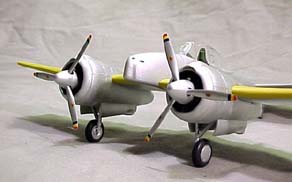 The
Minicraft long-nosed XF5F-1 is the same kit as their earlier short-nosed
release, with the addition of a new parts tree. Even so, construction
of this kit is simple and straightforward. The first step is to paint
everything Tamiya Flat Aluminum while the parts are still on the trees.
This will speed assembly and aid in sanding away seam lines later.
The
Minicraft long-nosed XF5F-1 is the same kit as their earlier short-nosed
release, with the addition of a new parts tree. Even so, construction
of this kit is simple and straightforward. The first step is to paint
everything Tamiya Flat Aluminum while the parts are still on the trees.
This will speed assembly and aid in sanding away seam lines later.
The first bit of assembly is the wing halves. Once they are together
and the seams sanded, mask and paint the Trainer Yellow upper surfaces
and the 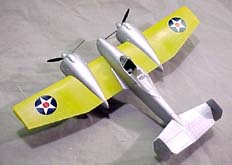 leading
edge of the lower surface. I chose to paint my cockpit in Testors Chromate
Green. You'll need to mask off the upper wing where the fuselage attaches.
The upper wing is also the cockpit floor. Dry fit the fuselage halves
and you'll see where you'll need to mask the wing to apply the Chromate
Green. Once the making is complete, shoot the cockpit floor area and the
inside of the fuselage halves. Don't worry about painting inside the long
nose, it won't be visible.
leading
edge of the lower surface. I chose to paint my cockpit in Testors Chromate
Green. You'll need to mask off the upper wing where the fuselage attaches.
The upper wing is also the cockpit floor. Dry fit the fuselage halves
and you'll see where you'll need to mask the wing to apply the Chromate
Green. Once the making is complete, shoot the cockpit floor area and the
inside of the fuselage halves. Don't worry about painting inside the long
nose, it won't be visible.
The cockpit is a little spartan, and the kit lacks any seatbelts/harnesses. I applied a spare lapbelt decal from a leftover sheet. The instrument panel is nicely detailed and with a little work, can be done up well. The instrument panel is attached to the wing, along with the seat and the control column.
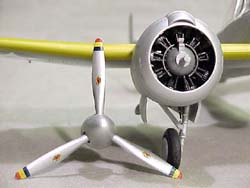 The
engines in this kit are very not bad! Minicraft provides some beautiful
intake and exhaust manifolds on the backside of the engines, and pushrod/ignition
harness detail of the front side. It is a pity that most of this detail
is not visible when the engines are installed inside their cowls. You'd
almost want to have a spare XF5F-1 kit around just for those engines.
The
engines in this kit are very not bad! Minicraft provides some beautiful
intake and exhaust manifolds on the backside of the engines, and pushrod/ignition
harness detail of the front side. It is a pity that most of this detail
is not visible when the engines are installed inside their cowls. You'd
almost want to have a spare XF5F-1 kit around just for those engines.
The assembled engines install into the cowl/main gear well halves. There is so much spare room inside these wheel wells, it is almost a pity not to put a 250lb bomb inside each one! Once the cowling subassemblies are together, sand the joints smooth.
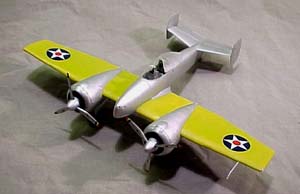 Assemble
the fuselage halves and join them to the wing/cockpit floor. The long
nose goes on at this point. Take a little extra time to fidget with the
nose-fuselage joint. At first blush, they don't appear to fit well, but
I found that with a little extra fidgeting, I got a good join with no
gaps or alignment problems.
Assemble
the fuselage halves and join them to the wing/cockpit floor. The long
nose goes on at this point. Take a little extra time to fidget with the
nose-fuselage joint. At first blush, they don't appear to fit well, but
I found that with a little extra fidgeting, I got a good join with no
gaps or alignment problems.
This is a good point to touch up the silver again after sanding the seams. To do the silver fuselage on the yellow wing might take a little masking, but I was able to simply apply two Postit Notes to each side to protect the wings. Touch-up complete!
The engine nacelles attach to the wing in the same way as the fuselage. Only a little fidgeting is required to get a snug fit. Once the undersides of the nacelle is in place, the overwing portion fits snugly. Likewise, the tail section also fits snugly in place. In face, no filler was required to build this kit. Don't get me wrong, a little filing and fitting is required, but there were no gaps evident and the whole project went together very nicely.
Painting
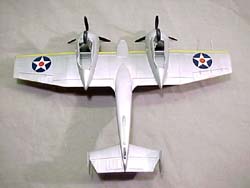 Since we
pre-painted most of the aircraft, we only have to do the touch-ups where
the Tenax removed the Tamiya Flat Aluminum. Once complete, a quick rub
down of the aircraft with an old t-shirt to remove any rough surfaces
in the paint, and then a coat of Future.
Since we
pre-painted most of the aircraft, we only have to do the touch-ups where
the Tenax removed the Tamiya Flat Aluminum. Once complete, a quick rub
down of the aircraft with an old t-shirt to remove any rough surfaces
in the paint, and then a coat of Future.
Decals
These are Scalemaster decals. They went on without any setting solution. These decals took the longer than any other decal I can remember to soak and move off the backing. Nonetheless, once they did move, the set down nicely. One nice touch – Minicraft provides the propeller tip warning stripes as decals, making the final steps much easier.
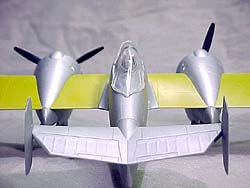 After
installing the canopy and windscreen, we are finally done. The transparent
parts are the only weakness in this kit. The transparencies in my example
were slightly cloudy, though dipping them into Future might solve the
problem. As you see in the photos, the canopy looks fine until you get
really close, so this shouldn't pose a problem.
After
installing the canopy and windscreen, we are finally done. The transparent
parts are the only weakness in this kit. The transparencies in my example
were slightly cloudy, though dipping them into Future might solve the
problem. As you see in the photos, the canopy looks fine until you get
really close, so this shouldn't pose a problem.
Since the XF5F-1 never entered service, the color schemes and markings are rather plain. This might be an opportunity to paint the aircraft up in the pre-war colors that might have been applied had it entered service. I know this might be a little revolting to the historical modeling purists, but a little fun is in order once in a while!
Conclusions
This kit goes together smoothly and, while a little spartan in the cockpit details, will provide the detail modeler an excellent starting point to superdetail this important piece of naval aviation history. I recommend this model to any builder. My sincere thanks to Minicraft for this review sample!

Previous: Contents









